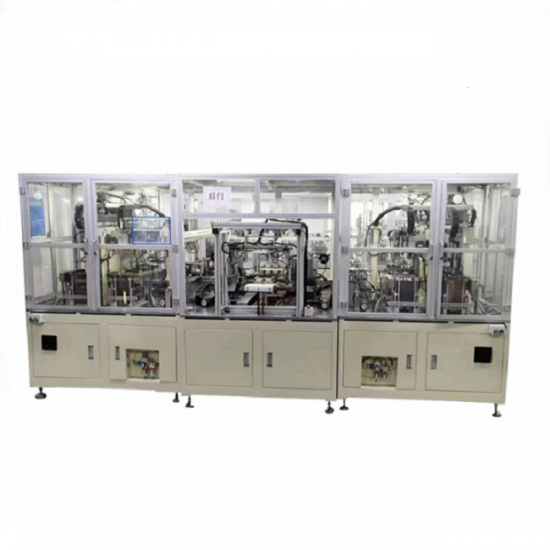Prismatic Cell Fabrication Equipment: Essential Tools for High-Precision Battery Manufacturing
The fabrication of prismatic cells involves a specialized range of equipment designed to handle various processes with precision, consistency, and safety. Prismatic cells, with their rectangular design, are widely used in electric vehicles (EVs), renewable energy storage, and consumer electronics. Their compact structure and high energy density make them ideal for applications where efficient use of space is crucial. Here’s a look at the key equipment used in prismatic cell fabrication:
● Key Prismatic Cell Fabrication Equipment
1. Mixing and Slurry Preparation Equipment
- Mixers: Mixing machines combine active materials (such as lithium compounds for cathodes and graphite or silicon for anodes), binders, solvents, and conductive additives to create a homogenous slurry. High-precision mixing ensures consistency in the electrode material.
- High-Speed Dispersers: These are used to break down particles and evenly distribute them within the slurry, optimizing the electrochemical performance of the electrodes.
2. Coating Machines
- Slurry Coating Machine: Coats the prepared electrode slurry onto metal foils (typically aluminum for cathodes and copper for anodes). The coating machine applies the slurry with precise control over thickness and uniformity, ensuring optimal performance.
- Drying Units: As part of the coating machine, these dry the coated electrodes to evaporate solvents, leaving a consistent layer of active material on the foils.
3. Calendering Machines
- Calender Rollers: Calendering machines apply high pressure to compress the coated electrode sheets to a precise thickness. This increases the density and uniformity of the active material, improving the cell's energy density and durability.
4. Cutting and Notching Machines
- Electrode Cutting Machine: High-speed, precision cutters are used to cut electrodes to specific dimensions. This process is essential for consistent layer size and cell assembly.
- Notching Machines: Notching creates specific patterns or shapes on the electrode edges, allowing for improved stacking and space utilization within the prismatic casing. Precision is critical to prevent short circuits and ensure cell longevity.
5. Stacking and Winding Machines
- Stacking Machine: Prismatic cells often use a stacked structure, where layers of anode, separator, and cathode are sequentially placed. Automated stacking machines align and place each layer with high accuracy.
- Z-Folding Equipment: For certain prismatic cells, Z-folding machines place the separator in a folded pattern, creating a stack of alternating anode and cathode layers that maximizes capacity and stability.
6. Vacuum Electrolyte Filling Machine
- Electrolyte Injector: The electrolyte is injected under vacuum conditions to ensure complete penetration throughout the cell, preventing air pockets and improving ion mobility.
- Degassing Units: After electrolyte filling, some equipment includes degassing to remove any trapped air, improving the cell's performance and reducing risk factors.
7. Sealing Equipment
- Heat Sealing Machines: Heat sealing equipment closes the prismatic cell casing, usually made of aluminum or polymer-laminated materials, to create a robust, leak-proof enclosure.
- Laser Welding Machines: For added structural integrity, laser welding machines provide strong, airtight seals on cell edges. Laser welding is especially popular in EV applications for its precision and reliability.
8. Formation and Aging Equipment
- Formation Cyclers: Formation cycling equipment performs the initial charge and discharge cycles on the cells, activating the electrochemical materials. This process stabilizes capacity and voltage for consistent cell performance.
- Aging Cabinets: After formation, cells are placed in controlled environments (aging cabinets) to rest, allowing quality checks for capacity retention, stability, and overall performance.
9. Testing and Quality Control Equipment
- Capacity Testing Units: Automated units test each cell’s capacity to ensure it meets the specified performance requirements.
- Safety Testing Systems: These systems test for internal resistance, voltage consistency, and thermal stability. Additional safety checks may include puncture, crush, and short-circuit testing, especially for EV cells.
10. Handling and Transfer Systems
- Robotic Arms and Conveyors: Automated handling systems, such as robotic arms and conveyor belts, transport cells from one station to the next. They help minimize human contact, reducing contamination risk and maintaining a sterile environment.
● Advantages of Automatic Stacking Machine
1. High Precision: Specialized machines ensure consistent, high-precision manufacturing, essential for high-performance batteries.
2. Automation Potential: The prismatic cell fabrication process is highly automatable, reducing labor costs and improving consistency.
3. Customizable Production Lines: Equipment can be tailored to manufacture cells of various sizes and capacities to meet industry demands.
4. Safety Assurance: Fabrication equipment includes safety measures that reduce risks associated with handling lithium-ion materials, such as leakage and thermal runaway.
● Applications of Prismatic Cells
Prismatic cells produced on these lines are primarily used in:
- Electric Vehicles (EVs): Prismatic cells offer high energy density in a compact form, making them a top choice for EV battery packs.
- Renewable Energy Storage: Prismatic cells are used in residential and commercial energy storage solutions, providing reliable power from solar and wind sources.
- Consumer Electronics: Some prismatic cells power devices like laptops, tablets, and high-capacity power banks.
● Conclusion
Prismatic cell fabrication equipment is a cornerstone of modern battery production, enabling the mass manufacture of reliable, high-performance batteries with the precision, consistency, and safety needed for demanding applications. With advancements in automation and technology, prismatic cell lines are meeting the energy storage needs of industries from transportation to electronics and renewable energy, shaping the future of sustainable power solutions.

